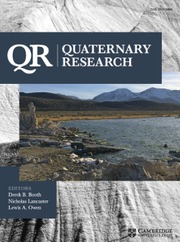Article contents
Multi-millennial streamflow dynamics in two forested watersheds on Vancouver Island, Canada
Published online by Cambridge University Press: 20 January 2017
Abstract
Holocene streamflow was reconstructed for two rivers on Vancouver Island, British Columbia, Canada in 500-yr intervals. The San Juan River watershed is located on the wetter western side of the island, whereas the Koksilah River watershed is positioned on the drier eastern side. Both watersheds are forested. To reconstruct streamflow, temporal changes in precipitation (estimated using a pollen-based transfer function) and evapotranspiration were established for each watershed and integrated into a water balance model, calibrated using modern data. While seasonal streamflow variability was maintained throughout the Holocene, with greater flow in the winter relative to the summer, the amount of discharge has changed markedly through time. Lowest simulated flow occurred in the earliest Holocene, with low-flow conditions beginning earlier in the year and extending later into the fall. Such conditions may have inhibited salmon from using many of the smaller rivers in the region. Streamflow steadily increased throughout the early Holocene so that by ca. 6500 cal yr before present near-modern flow regimes were established. As climate changes in the future, the San Juan and Koksilah watersheds are expected to remain as pluvial hydroclimatic regimes, though with an extended season of low flow similar to conditions during the early Holocene.
Information
- Type
- Original Articles
- Information
- Copyright
- University of Washington
References
- 9
- Cited by

